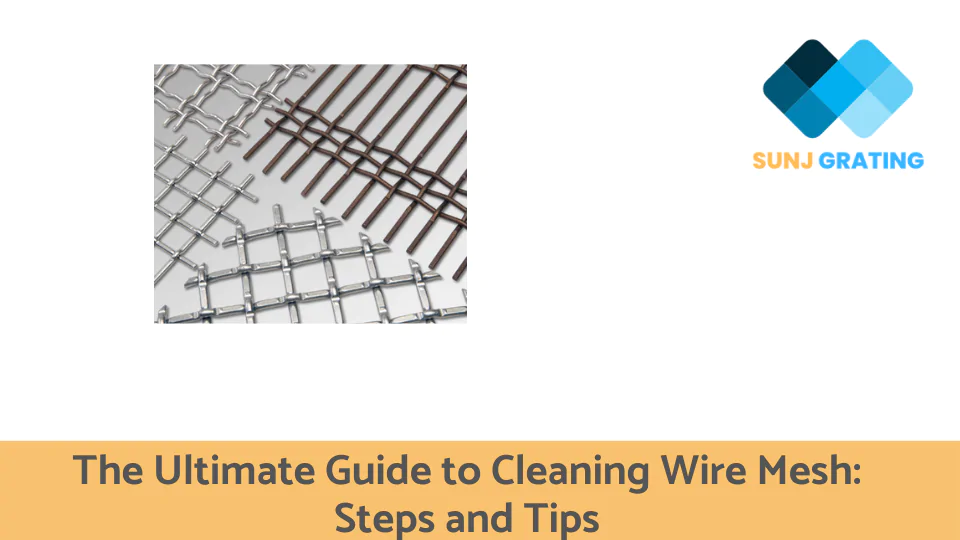Introduction
Wire mesh is important in many industries, but keeping it clean and free of dirt and bacteria can be challenging. That’s why we have compiled the ultimate guide to cleaning wire mesh, with tips and tricks to help you maintain the integrity and effectiveness of your mesh.
Cleaning wire mesh is essential to ensure it remains effective, and there are additional tips and tricks that you might not have thought of. In this guide, we cover everything from boiling the mesh before cleaning to avoiding abrasive materials, helping you keep your wire mesh in top condition.
1. Types of wire mesh

Welded wire mesh
It is made by welding individual wires together at their intersections. The wires used in welded wire mesh can be either plain or ribbed and are usually made of steel. The intersections between the wires are welded together using an electric resistance welding process.
This process creates a very strong and rigid mesh that is resistant to deformation and stretching. Welded wire mesh is commonly used in construction, agriculture, and industrial applications where strength and durability are essential.
Weave wire mesh
On the other hand, is made by weaving individual wires together in an interlocking pattern. The wires used in weave wire mesh can be made of a variety of materials, including steel, stainless steel, aluminum, and copper.
The weaving process can create a range of different patterns, including plain weave, twill weave, and Dutch weave. Weave wire mesh is known for its flexibility and versatility and can be used in a variety of applications, including filtration, screening, and separation.
Differences between them
One of the main differences between welded wire mesh and weave wire mesh is their strength and rigidity. Welded wire mesh is generally stronger and more rigid than weave wire mesh, which makes it ideal for applications where strength and durability are important.
Weave wire mesh, on the other hand, is more flexible and versatile, making it suitable for applications where filtration or screening is needed.
Another difference between the two types of wire mesh is their cost. Welded wire mesh is generally less expensive than weave wire mesh because the manufacturing process is simpler and requires less material.
In terms of applications, welded wire mesh is commonly used in construction for reinforcing concrete structures, fencing, and animal enclosures. Weave wire mesh, on the other hand, is used in a wide range of applications, including filtration and separation, screen printing, and architectural design.
2. Why it’s necessary to clean wire mesh

Check wear status
Checking the wear status of wire mesh is important because over time, the wire mesh can become damaged or worn out due to exposure to harsh environmental conditions or heavy use. When wire mesh becomes worn or damaged, it can lose its strength and integrity, which can compromise its performance and effectiveness.
Regularly checking the wear status of wire mesh can help to identify any issues early on, allowing for prompt repairs or replacements, which can help to ensure that the wire mesh continues to function properly.
Prevent bacterial growth
Wire mesh is commonly used in food processing and medical applications, and as such, it is essential to prevent bacterial growth on the surface of the mesh. Bacteria can quickly multiply on the surface of wire mesh, creating a potential health hazard for those who come into contact with it.
Cleaning wire mesh regularly with appropriate disinfectants can help to prevent the growth and spread of bacteria, helping to maintain a clean and hygienic environment.
Remove dirt accumulation
Over time, wire mesh can accumulate dirt, debris, and other contaminants, which can negatively impact its performance and effectiveness. Dirt and debris can clog the openings in the wire mesh, reducing airflow or filtration capacity, which can compromise the overall performance of the mesh.
Regular cleaning of wire mesh can help to remove dirt accumulation, ensuring that it continues to function effectively. Additionally, removing dirt accumulation can help to extend the lifespan of wire mesh, reducing the need for frequent replacements and associated costs.
3. Steps of cleaning wire mesh

| Steps of cleaning wire mesh | Tips for cleaning wire mesh |
| Step 1. Soak in the mild water Step 2. Flush the mesh Step 3. Use soft brush Step 4. Flush again and wipe it | Tip 1. Boil the mesh in water before cleaning Tip 2. Avoid steel wool Tip 3. Avoid strong bleaches |
Step 1. Soak in mild water
The first step in cleaning wire mesh is to soak it in mild water. Fill a container with lukewarm water and add a small amount of mild detergent or soap. Submerge the wire mesh in the water and let it soak for a few minutes to loosen any dirt or debris.
Step 2. Flush the mesh
After soaking, flush the wire mesh thoroughly with clean water to remove any loose dirt or debris. Use a hose or a faucet to run water through the mesh from one end to the other. This will help to remove any dirt or debris that has become dislodged during the soaking process.
Step 3. Use a soft brush
Once the wire mesh has been flushed, use a soft-bristled brush to gently scrub the surface of the mesh. This will help to remove any remaining dirt or debris that may be stuck to the surface of the wire mesh. Be sure to use a soft-bristled brush to avoid damaging the mesh.
Step 4. Flush again and wipe it
After brushing, flush the wire mesh again with clean water to remove any remaining dirt or soap residue. Once the mesh has been thoroughly rinsed, use a clean cloth to wipe it down and remove any excess water. Allow the wire mesh to air dry completely before using it again.
4. Other Tips

Boil the mesh in water before cleaning
Boiling the wire mesh in water for a few minutes before cleaning can help to loosen any stubborn dirt or debris that may be stuck to the surface of the mesh. This can make it easier to remove the dirt or debris during the cleaning process. However, be sure to allow the wire mesh to cool down before handling it, as it may be hot and can cause burns.
Avoid steel wool
Steel wool or other abrasive materials should be avoided when cleaning wire mesh. These materials can scratch or damage the surface of the mesh, reducing its effectiveness and potentially causing it to wear out more quickly. Instead, use a soft-bristled brush or a sponge to clean the wire mesh.
Avoid strong bleaches
Strong bleaches or harsh chemicals should be avoided when cleaning wire mesh. These can damage the surface of the mesh, causing it to corrode or deteriorate over time. Instead, use mild detergents or soaps and rinse the mesh thoroughly with clean water to remove any soap residue.
Conclusion
In conclusion, maintaining a clean and bacteria-free wire mesh maximizes its performance and longevity. By following the steps and tips outlined in this comprehensive guide to cleaning wire mesh, you can ensure that your wire mesh remains in optimal condition and continues to function effectively.
We encourage you to use this guide as a reference to help you maintain clean and well-functioning wire mesh for all of your applications.


